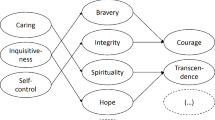Abstract
Recently, psychologists have begun to shift their research attention to positive topics historically overlooked by the profession. The study of character strengths is a major research interest of positive psychologists. A classification of 24 character strengths, called the Values in Action (VIA) Classification, has recently been developed, and the current study evaluates these character strengths across cultures. Among 123 members of the Kenyan Maasai, 71 Inughuit in Northern Greenland, and 519 University of Illinois students, we found high rates of agreement about the existence, desirability, and development of these strengths of character. Despite these strong similarities, there were differences between and within cultures in terms of gender, the perceived importance of specific strengths (such as modesty), and the existence of cultural institutions that promote each strength.
Similar content being viewed by others
References
InstitutionalAuthorNameAmerican Psychiatric Association (1994) Diagnostic and Statistical Manual of Mental Disorders EditionNumber4 American Psychiatric Association Washington, DC
Aquinas: 1269/1987, ‘Summa theologica’, in R.M. Hutchins (ed.), Great Books of the Western World, Vol. 19 (William Benton, Chicago), pp. 3–826
Aristotle (1986) The Nicomachaen Ethics Macmillan Publishing New York
L.E. Atwater S.D. Dionne B. Aviolo J.F. Camboreco A.W. Lav (1999) ArticleTitle‘A longitudinal study of the leadership development process: individual differences predicting leader effectiveness’ Human Relations 52 1543–1562
Augustine: 426/1987, ‘The city of God’, in R.M. Hutchins (ed.), Great Books of the Western World, Vol. 18 (William Benton, Chicago), pp. 129–618
K. Bhui (1999) ArticleTitle‘Common mental disorders among people with origins in or immigration from India and Pakistan’ International Review of Psychology 11 136–144 Occurrence Handle10.1080/09540269974302
R. Biswas-Diener J. Vitterso E. Diener (2005) ArticleTitle‘‘Most people are pretty happy, but there is cultural variation: The Inughuit, The Amish, and the Maasai’’ Journal of Happiness Studies 6 205–226 Occurrence Handle10.1007/s10902-005-5683-8
Brochmann, H.: 2001, Detention in Greenland: Night-time correctional institutions, probation and hostels for juvenile offenders as seen by inmates and staff. Man & Society 25 Danish Polar Center, Copenhagen
J. Cassell (2002) ArticleTitle‘Perturbing the system: “Hard Science,” “soft science,” and social science, the anxiety and madness of method’ Human Organization 61 177–185
R.W. Coan (1977) Hero, Artist, Sage, or Saint? Columbia University Press New York
P. Collings (2001) ArticleTitle‘“If you got everything, it’s good enough”: perspectives on successful aging in a Canadian Inuit community’ Journal of Cross-Cultural Gerontology 16 127–155 Occurrence Handle10.1023/A:1010698200870
P. Cramer G. Anderson (2003) ArticleTitle‘Ethnic/racial attitudes and self-identification of Black Jamaican and White New England children’ Journal of Cross-Cultural Psychology 34 395–416 Occurrence Handle10.1177/0022022103034004002
L.H. Eckensberger (1994) Moral development and its measurement across cultures W.J. Lonner R. Malpass (Eds) Psychology and Culture Allyn and Bacon Boston 71–78
P.C. Ellsworth (1994) Sense, culture, and sensibility S. Kitiyama H.R. Markus (Eds) Emotion and Culture: Empirical Studies of Mutual Influence American Psychological Association Washington, DC 23–50 Occurrence Handle10.1037/10152-001
Kant: 1785/1987, ‘Introduction to metaphysical elements of ethics’, in R.M. Hutchins (ed.), Great Books of the Western World, Vol. 42 (William Benton, Chicago), pp. 366–379
L. Kohlberg (1981) The Philosophy of Moral Development: Essays on Moral Development NumberInSeriesVol. 1 Harper & Row San Francisco
R. Levine (1997) A Geography of Time Basic Books New York
A. Lynge (2002) The Right to Return: Fifty Years of Struggle by Relocated Inughuit in Greenland Atuagkat Publishers Nuuk, Greenland
V. Ma T.J. Schoeneman (1997) ArticleTitle‘Individualism versus collectivism: a comparison of Kenyan and American self-concepts’ Basic & Applied Social Psychology 19 261–273 Occurrence Handle10.1207/s15324834basp1902_7
H.R. Markus S. Kitiyama (1994) The cultural construction of self and emotion: implications for social behavior S. Kitiyama H.R. Markus (Eds) Emotion and Culture: Empirical Studies of Mutual Influence American Psychological Association Washington, DC 89–130 Occurrence Handle10.1037/10152-003
A.H. Maslow (1954) Motivation and Personality Harper & Row New York
U. Menon R.A. Shweder (1998) The return of the “white man’s burden”: the moral discourse of anthropology and the domestic life of Hindu women R.A. Shweder (Eds) Welcome to Middle Age! (And Other Cultural Fictions) University of Chicago Press Chicago 139–188
F.V. O’Callighan T. Haman (2003) ArticleTitle‘Normalization of marijuana use: its effects on adolescents’ intentions to use marijuana’ Substance Use & Misuse 38 185–199 Occurrence Handle10.1081/JA-120017244
N. Park C. Peterson M.E.P. Seligman (2004) ArticleTitle‘Strengths of character and well-being’ Journal of Social & Clinical Psychology 23 603–619 Occurrence Handle10.1521/jscp.23.5.603.50748
C. Peterson M.E.P. Seligman (2003) ArticleTitle‘Character strengths before and after September 11’ Psychological Science 14 381–384 Occurrence Handle10.1111/1467-9280.24482
C. Peterson M.E.P. Seligman (2004) Character Strengths and Virtues: A Handbook and Classification American Psychological Association Washington, DC
D.N. Robinson (1997) ArticleTitle‘Therapy as theory and civics’ Theory and Psychology 7 675–681
T. Saitoti (1986) The Worlds of a Maasai Warrior University of California Press Berkeley and Los Angeles
T.A. Steen L.V. Kachorek C. Peterson (2003) ArticleTitle‘Character strengths among youth’ Journal of Youth and Adolescence 32 5–16 Occurrence Handle10.1023/A:1021024205483
H. Stuart J. Arboleda-Florez (2001) ArticleTitle‘Commonly held attitudes toward people with schizophrenia’ Canadian Journal of Psychiatry 46 245–252
E.M. Suh (2000) Self, the hyphen between culture and subjective well-being E. Diener E.M. Suh (Eds) Culture and Subjective Well-Being Cambridge MIT Press 63–86
W. Tatarkiewicz (1976) Analysis of Happiness Martinus Nijhoff The Hague
H.C. Triandis (1995) Individualism and Collectivism Westview Press Boulder
V. Wikan (1989) ArticleTitle‘Illness from fright or soul loss: a North Balinese culture-bound syndrome?’ Culture, Medicine, & Psychiatry 13 25–50 Occurrence Handle10.1007/BF00052681
Author information
Authors and Affiliations
Corresponding author
Rights and permissions
About this article
Cite this article
Biswas-Diener, R. From the Equator to the North Pole: A Study of Character Strengths. J Happiness Stud 7, 293–310 (2006). https://doi.org/10.1007/s10902-005-3646-8
Issue Date:
DOI: https://doi.org/10.1007/s10902-005-3646-8




